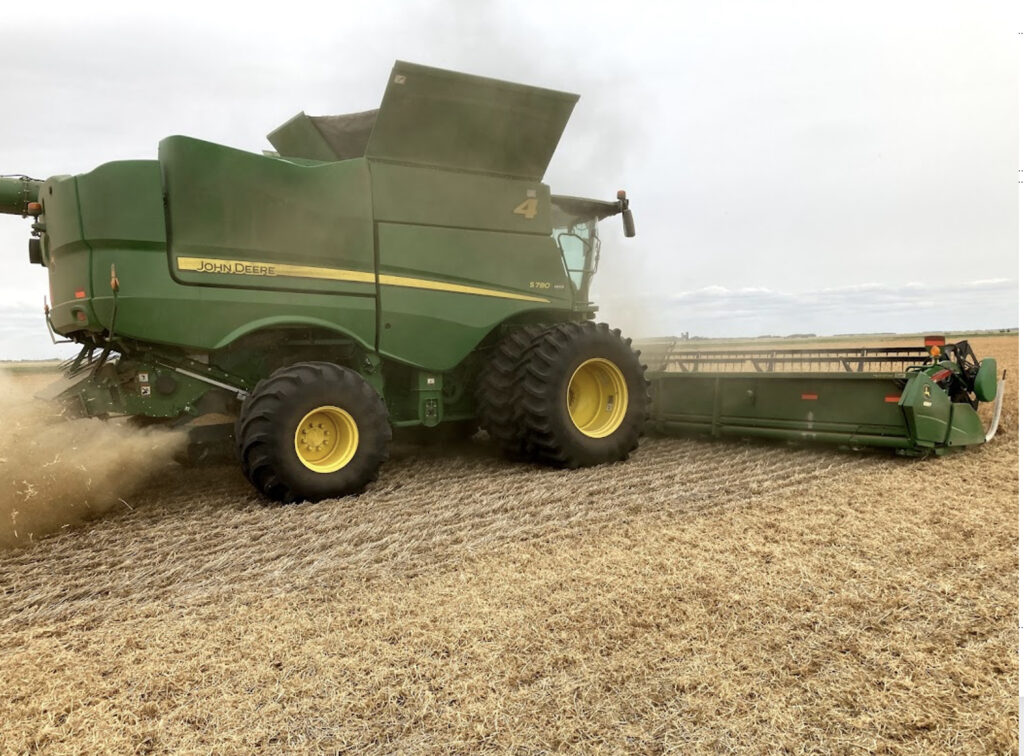
Features
Top Crop Summit
Weed Management
Top Crop Summit series: The adoption of physical impact mills
March 28, 2024 By Bruce Barker
 An estimated 30 impact mills are operating on the Prairies.
Photo by Josh Lade
An estimated 30 impact mills are operating on the Prairies.
Photo by Josh Lade Breanne Tidemann is a research scientist with Agriculture and Agri-Food Canada at Lacombe, Alta. At the Top Crop Summit on Feb. 27-28 in Saskatoon, she shared key feedback from producers using impact mills in their day-to-day harvest, showcasing farm types, associated costs, benefits, challenges and strategies implemented.
Harvest weed seed control (HWSC) is a new paradigm of weed control that was developed and refined in Australia. Its goal is to manage weed seeds at harvest to prevent dispersal. For HWSC to be effective, weed seeds must be retained on the plant at harvest. Weed seeds also need to be at a height where they will be collected by the combine.
There are multiple methods of HWSC including narrow windrow burning, bale direct systems, chaff lining/tramlining, chaff carts and physical impact mills. Physical impact mills, sometimes also called seed impact mills, were pioneered in Australia as a pull-behind unit but are now integrated into the combine to collect chaff going over the sieves.
Impact mills are thought to be the best fit for HWSC in Canada because they can be integrated into the combine, leave residue on the field and don’t require fire to destroy the weed seeds.
Research at AAFC-Lacombe looked at wild oat, cleavers and canola seed retention. It found that almost all canola seed was retained on the plant until faba bean crop harvest at the end of September, while cleaver retention started to decline around the end of August, but wild oat retention started to decline in early August. The results were found to be environment/year-dependent and cropping system-dependent.
Seed mortality after going through an impact mill was greater than 95 per cent for kochia, green foxtail, cleavers, volunteer canola and wild oat found in barley chaff, and generally, chaff type didn’t affect the efficacy of the machine. If you can get the weed seed into the impact mill, it is very effective.
In-field research was conducted near Lacombe from 2017 to 2019 with the original Harrington Seed Destructor on 20 producer fields. The results found limited impact on the weed seedbank and likely required a longer time frame to see an impact. The research was also conducted in very weedy areas of the field so the weed seedbank was high to begin with. As a result, the research didn’t give a definitive result one way or the other.
A producer survey looked at cost and benefits
An estimated 30 impact mills are operating on the Canadian Prairies. A survey was conducted in collaboration with AAFC research scientists Charles Geddes and Shaun Sharpe. It was circulated with the cooperation of impact mill manufacturers, on X (Twitter) and LinkedIn. Ten farmers with 18 impact mills completed the survey. Most were centered around Saskatoon, likely due to one of the manufacturers, and the distributor for a second manufacturer both being located in the area.
The majority of respondents had farm size greater than 3,000 acres, with 40 per cent of respondents having more than 10,000 acres. Six of the producers had all of their combines outfitted with an impact mill, two had impact mills on half their combines and two had impact mills on one-in-four of their combines.
Fifty per cent of respondents said the main reason for adoption was to manage current and future herbicide resistance. At 40 per cent of respondents, reducing and managing the weed seed bank and reducing weed densities were the other main drivers of adoption. Other reasons were the noted success in Australia and local farms, the need to reduce chemical use and reduce weed densities before adopting site-specific application technology.
Sixty per cent of producers identified wild oat as the main driver weed they were targeting, 50 per cent were targeting kochia and 30 per cent of producers were targeting all weeds.
Additional fuel use during operation was estimated at between 50 cents to $2 per acre with an average of $1.40 per acre. Annual maintenance costs ranged from $1,000 to $5,000, with the average cost pegged around $1,500. These operating costs were found to be low compared to other U.S. estimates. Some of the producers had only one year of use, so their cost estimates could also be viewed as preliminary.
The number one challenge for producers using impact mills was green material going through the combine and plugging up the mill. It has particularly been an issue with large, dense kochia patches.
Of the longer-term adopters, three producers reported reduced weed densities and reduced spread of weed patches. The average density reduction was estimated at 62 per cent. For producers who were not using an impact mill on every acre, they were using them on combines in the opening rounds, for weed patches and on slough and saline areas.
Feedback from respondents looked at the time frame to pay off the investment in a $100,000+ impact mill. Ten per cent thought one to two years, 60 per cent thought three to five years, 20 per cent estimated six to eight years and 10 per cent estimated more than 10 years.